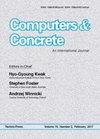Post-fire flexural behavior of functionally graded fiber-reinforced concrete containing rubber
IF 3.3
4区 工程技术
Q2 COMPUTER SCIENCE, INTERDISCIPLINARY APPLICATIONS
引用次数: 12
Abstract
The optimal distribution of steel fibers over different layers of concrete can be considered as an appropriate method in improving the structural performance and reducing the cost of fiber-reinforced concrete members. In addition, the use of waste tire rubber in concrete mixes, as one of the practical ways to address environmental problems, is highly significant. Thus, this study aimed to evaluate the flexural behavior of functionally graded steel fiber-reinforced concrete containing recycled tire crumb rubber, as a volume replacement of sand, after exposure to elevated temperatures. Little information is available in the literature regarding this subject. To achieve this goal, a set of 54 one-, two-, and three-layer concrete beam specimens with different fiber volume fractions (0, 0.25, 0.5, 1, and 1.25%), but the same overall fiber content, and different volume percentages of the waste tire rubber (0, 5, and 10%) were exposed to different temperatures (23, 300, and 600oC). Afterward, the parameters affecting the post-heating flexural performance of concrete, including flexural strength and stiffness, toughness, fracture energy, and load-deflection diagrams, along with the compressive strength and weight loss of concrete specimens, were evaluated. The results indicated that the flexural strength and stiffness of the three-layer concrete beams respectively increased by 10 and 7%, compared to the one-layer beam specimens with the same fiber content. However, the flexural performance of the two-layer beams was reduced relative to those with one layer and equal fiber content. Besides, the flexural strength, toughness, fracture energy, and stiffness were reduced by approximately 10% when a 10% of natural sand was replaced with tire rubber in the threelayer specimens compared to the corresponding beams without crumb rubber. Although the flexural properties of concrete specimens increased with increasing the temperature up to 300oC, these properties degraded significantly with elevating the temperature up to 600oC, leading to a sharp increase in the deflection at peak load.含橡胶功能级配纤维增强混凝土的火灾后抗弯性能
钢纤维在混凝土各层间的优化分布是提高结构性能和降低纤维增强混凝土构件成本的一种合理方法。此外,在混凝土中使用废旧轮胎橡胶,作为解决环境问题的实用方法之一,意义重大。因此,本研究旨在评估含有再生轮胎碎橡胶的功能分级钢纤维增强混凝土,作为沙子的体积替代品,在暴露于高温后的弯曲行为。关于这一主题的文献资料很少。为了实现这一目标,将54个纤维体积分数(0、0.25、0.5、1和1.25%)不同,但总纤维含量相同,废轮胎橡胶体积百分比(0、5和10%)不同的一层、两层和三层混凝土梁试件暴露在不同的温度下(23、300和600℃)。随后,评估了影响混凝土热后抗弯性能的参数,包括抗弯强度和刚度、韧性、断裂能、荷载-挠度图,以及混凝土试件的抗压强度和减重。结果表明:与纤维含量相同的单层梁试件相比,三层混凝土梁的抗弯强度和刚度分别提高了10%和7%;然而,两层梁的抗弯性能相对于一层梁和同等纤维含量的梁有所降低。此外,在三层梁中,当用轮胎橡胶代替10%的天然砂时,其抗弯强度、韧性、断裂能和刚度比不加橡胶屑的梁降低了约10%。当温度达到300℃时,混凝土试件的抗弯性能随温度升高而增加,但当温度达到600℃时,试件的抗弯性能明显下降,峰值挠度急剧增加。
本文章由计算机程序翻译,如有差异,请以英文原文为准。
求助全文
约1分钟内获得全文
求助全文
来源期刊

Computers and Concrete
工程技术-材料科学:表征与测试
CiteScore
8.60
自引率
7.30%
发文量
0
审稿时长
13.5 months
期刊介绍:
Computers and Concrete is An International Journal that focuses on the computer applications in be considered suitable for publication in the journal.
The journal covers the topics related to computational mechanics of concrete and modeling of concrete structures including
plasticity
fracture mechanics
creep
thermo-mechanics
dynamic effects
reliability and safety concepts
automated design procedures
stochastic mechanics
performance under extreme conditions.
 求助内容:
求助内容: 应助结果提醒方式:
应助结果提醒方式:


